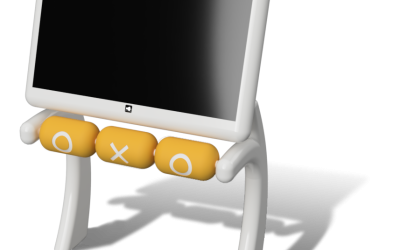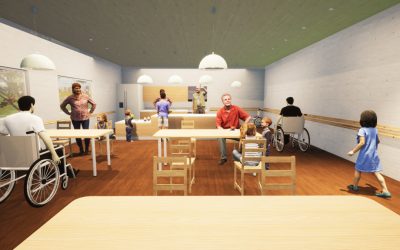보조기기의 사용성은 사용자의 다양한 역할에서의 참여 수준을 보여준다. 수동 휠체어와 달리, 전동휠체어는 중증 장애인인 사용자가 그들의 잔존 기능을 사용하여 휠체어를 조작한다. 이 때문에 전동 휠체어의 사용자 인터페이스는 복잡하고 다양하다. 하지만 전동 휠체어는 수동 휠체어보다 사용자 개개인의 요구를 반영할 수 있는 제품들이 상당히 제한적이다. 전동 휠체어는 의료기기로서 규제되고 있다. 한국의 식품의약품안전처와 미국의 FDA에 따르면 제조사는 사용성 공학 표준에 따라 의료기기를 개발해야 한다.
본 연구에서는 전동 휠체어의 사용성을 증진하기 위한 전동 휠체어의 사용자 인터페이스 디자인 가이드라인을 개발하고자 하였다. 중증 척수 손상 장애인 15명을 대상으로 사용자 조사를 수행하였다. 사용자 특성, 사용 현황, 사용 요구사항이라는 사용자 조사 결과를 바탕으로, 전동 휠체어 사용자 인터페이스 요소의 사용성을 보장하기 위한 디자인 목표를 위해 가이드라인을 개발하였다. 또한, 이러한 가이드라인은 다섯 명의 보조 공학, 휠체어 관련 전문가의 검토를 거쳤다.
사용자 인터페이스 디자인 가이드라인은 사용자 인터페이스 요소를 이동, 자세 지지, 유틸리티를 위한 사용자 인터페이스 세 가지로 구분하여 도출하였다. 중증 척수 손상 장애인을 위한 전동 휠체어 전체에 요구되는 것은 사용자 친화적으로 디자인되어야 하며, 직관성과 학습능력이 높아야 한다는 것이다. 또한, 기능이 많을수록 휠체어의 부피가 커지게 되는데 이는 장애의 정도를 더욱더 심하게 보이도록 한다. 이러한 거부감을 줄이면서 사용성을 높이도록 해야 한다. 이에 더해, 사용자가 원하는 자세로 전동 휠체어를 움직이고 조작할 수 있어야 하며 이러한 조작에 대한 반응은 명확하고, 빠르며, 일관성이 있어야 한다.
본 연구에서 도출한 가이드라인을 바탕으로 개발된 제품 또는 소비자에 의해 선택된 휠체어는 개발과 선택의 이질감을 최소화할 수 있을 것으로 기대한다. 또한, 임상 전문가는 휠체어 처방의 가이드로써 사용할 수 있을 것이다. 본 연구의 결과는 사용자 인터페이스 디자인의 초기 단계인 사용자 명세와 사용자 인터페이스 디자인 명세만을 다루고 있다. 따라서 사용자 인터페이스 디자인의 후기 단계인 형성 평가와 총괄 평가를 다루는 후속 연구가 필요하다.
1. Introduction
If people could have one superpower, most people would say that they’d like to have the power of teleportation. This shows the importance of mobility. In the article “Measuring Usability of Assistive Technology,” it is claimed that “human mobility is inherently central to well-being and occupational performance, and evaluating and optimizing the usability of a wheelchair has direct implications on user participation.” (Arthanat et al 761) Although user interface and usability are important factors in the use of a wheelchair, the article “Evaluation of Distinct Input Methods of an Intelligent Wheelchair” claims that “Many [Intelligent Wheelchair] prototypes are being developed in research projects around the world; however, the adaptation of their user interface to the patients’ individual characteristics is an often neglected research topic.” (Mónica et al 3) Here powered wheelchair interface should be understood to be a powered wheelchair component that affects the usability of the powered wheelchair and interacts with the user. Powered wheelchairs have a complex and diverse user interface that is designed in accordance with the user’s characteristics, other assistive devices, caregiver attendance, social activities, usage environment and context.
Up to now, most studies on the usability of powered wheelchairs written by clinical experts have been focused on usability evaluation and measurement studies. (Agnes et al 127) However, the article “Measuring Usability of Assistive Technology” qualitatively investigated powered wheelchair usability and purpose, reflecting on the use environment. Evaluating the usability of a wheelchair using the USAT tool will yield results related to ‘What’ and ‘Who’, and will thereby inform matters such as usability issues (wheelchair use, reported problems, intervention possibility, and stakeholders). (Arthanat et al 761) However, wheelchair designers and developers need a study that explores ‘How’ users interact with wheelchairs in order to make improvements to wheelchair design. Therefore, this study differs from previous studies insofar as it explains how users interact with wheelchairs, assistive devices, caregivers and the environment. This study investigates the user characteristics of people with spinal cord injuries, the usage status of powered wheelchairs, and use requirements through user research. Based on the results of user research, the author has established design guidelines for powered wheelchair user interface for people with spinal cord injuries.
2. Method
User research was conducted on 15 subjects with high-level spinal cord injuries. Based on the results of the user research (taking into consideration user characteristics, usage status, and use requirements), powered wheelchair user interface guidelines were created to guarantee the usability of each powered wheelchair user interface element, and five experts in assistive technology and wheelchairs verified the guidelines. This research protocol has been reviewed and approved by the Institutional Review Board of Yonsei University Wonju Campus. (Approval number: 1041849-201805-SB-046-01)
The study subjects were divided into three groups according to powered wheelchair interface type: basic controller users, modified controller users, and special controller users. It is expected that this study will provide guidelines for how a user interface should be designed for each user’s characteristics by examining the similarities and differences between the user characteristics, usage status, and use requirements of each group. The basic controller is a controller such as a joystick provided by a powered wheelchair manufacturer. A special controller is a controller such as a sip and puff controller, a head controller, or a chin controller that are provided by a powered wheelchair manufacturer for users with limited hand movements. A modified controller refers to a controller that has been modified by a user, who does not have enough hand coordination to use the basic controller to provide real convenience. The number of subjects was determined to be five people per group (a total of 15 subjects). According to “Measuring the User Experience”, five participants will reveal about 80 percent of usability issues and the author claims that each participant will reveal about 30 percent of usability problems. Five different users per group are sufficient to identify most important usability issues. (Albert and Tullis, 152-154) The researcher asked the Korea Spinal Cord Injury Association to cooperate with subject recruitment, explaining the research directly to the research subjects and then proceeding with the recruitment.
Interview items were divided according to whether they related to user characteristics, wheelchair characteristics, main social activities or environment1. Each interview item was designed based on the Human Activity Assistive Technology (HAAT) model and the Matching Person and Technology (MPT) model. According to the article “Measuring Usability of Assistive Technology”, these models imply that the concept of usability for assistive technology (AT) should include a holistic understanding of the relationship between users, assistive technologies, activities and the environment. (Arthanat, 237) Additionally, observation proceeds by means of shadowing observation. The article “Universal Methods of Design” explains that shadowing is a form of observation and interviewing in which the observer follows the user like a shadow. Shadowing is a good way to observe outdoor activity while monitoring the users’ lifestyles and has the advantage of enabling observation of usage contexts and behaviors related to mobile- and automobile-related products and services. (Haninton et al 158)
These interviews and observations will be analyzed using the thematic analysis method. According to “Using Thematic Analysis in Psychology,” “Thematic analysis is a method for identifying, analyzing and reporting patterns (themes) within data.” (Baruun et al 79) The results of analysis are divided into three groups according to the types of powered wheelchair user interface. They are summarized as follows:
1) User characteristics: User characteristics and major social activities
2) Powered wheelchair usage: Characteristics of powered wheelchair user interfaces
3) Use requirements of powered wheelchairs: Advantages and disadvantages of powered wheelchairs, use requirements when driving or taking transportation, movement, meal-taking, work activity and social activity.
The development of medical devices must follow the usability engineering process standard (IEC 62366-1 27). Article IEC 62366-1 “specifies a process for analysis, regulation, design, verification and validation of usability related to the safety of medical devices. Minimizing usage errors and maximizing usability is the ultimate goal of usability engineering.” (27) For the user interface design, the process of creating the use specification and the user interface specification should be adhered to. In order to create such a specification, a user research activity must be undertaken. Therefore, in this study, I will identify user characteristics, powered wheelchair use status, and powered wheelchair use requirements, which can become the core contents of the use specification and user interface specification.
Finally, based on the results of the user research, user interface design guidelines for user interface elements were derived. One researcher derived the initial guidelines and four experts verified the guidelines. Expert verification was conducted in the form of a co-creation workshop. In the article “New Design Tools,” co-creation is a term referring to activities based on ‘collective creativity’, which refers to the creativity that appears in activities in groups of two or more people. (Lee J.J. et al 174)
3. User Interface Design Guidelines
According to the article “A Study on the Characteristics of the Design Guidelines”, “A design guideline is ‘a guide that provides additional information on design issues’ and is ‘a detailed description of how to achieve the design objective.’” (Park, S. Y. 7) Looking at the universal design guidelines study and the design guidelines study for the elderly (Hwang et al; Lee et al; Zaphiris et al), these guidelines are structured in a way that suggests a direction for design development that will enhance the usability of wheelchairs to reflect the needs and requirements of the user. This is a guide to usability goals that the design of various types of creative alternatives should have (see Figure 1).

In light of this guide, in this study, I have designed the powered wheelchair user interface design guidelines based on the results of the research (on user characteristics, usage status, and use requirements) to reflect design goals intended to guarantee the usability of each powered wheelchair user interface element. In addition, the guidelines are divided into three levels, necessary, and recommended 1 and 2. The necessary guidelines are for ensuring that the powered wheelchairs that are available on the market meet a certain level of usability. Alternatively, necessary guidelines may be guidelines that must be followed to satisfy safety and accessibility issues. The recommended guidelines 1 is the level of usability that the user needs but which the wheelchair does not have, when the implementation of corrections is realistic. Recommended level 2 represents an ideal implementation level. Recommended guidelines don’t have to be followed to ensure safety and accessibility. The additions made through the expert verification process are marked by an asterisk.
According to the article “The Effect of User Interface of Power Wheelchair”, the author analyzed a powered wheelchair user interface into three components, regarding user interface for mobility, user interface for posture support, and user interface for utility. (Agnes et al 17-18) Among the powered wheelchair components, examples of guidelines for wheels, controllers (user interface for mobility), and armrests (user interface for posture support) whose concepts vary according to the usage characteristics of the power wheelchair are as follows.


Joystick

4. Conclusion
Based on the results of the user research, the user interface design guidelines for each user interface element related to movement, posture support, and utility were derived. These are the author’s interpretation of the user research results. Among the user interface elements, the elements that are to be highlighted with respect to use requirements are wheels (including assistive wheels, anti-tip stabilizers), controllers, and armrests. What is required of the entire power wheelchair for people with high-level spinal cord injuries is: that the power wheelchair be designed to be user-friendly and increase intuition and learnability during an extended learning period that includes a trial-and-error process during the initial learning period; that, when the user has a feeling of discomfort because they feel that their disability is conspicuous, the usability be improved while addressing this objection; that the user be able to move or adjust their posture as desired and that the response to the operation be clear, fast, and consistent.
It is expected that the wheelchair or the product selected by the consumer based on these guidelines will minimize the heterogeneity of development and selection and that clinical experts will also be able to use them as a guide to wheelchair prescriptions. However, the results of this study are limited in that they only cover user specifications and user interface design specifications, which are the early stages of a user interface design. Therefore, it is necessary to conduct further formative evaluation and summative evaluation, to cover the later stages of the user interface design process. In addition, the user interface design guidelines were derived solely from the user research results. Additional user interface design guideline studies should be undertaken that reflect the needs of medically required designs rather than usage and requirements, as well as the needs of stakeholders, such as power wheelchair prescriptions or service personnel and developers.
- Interview items are as follow:
1) User characteristics: Sex, age, diagnosis, complications, occupation, K-MBI Score (Korean version-Modified Barthel Index), AIS.
2) Main social activity and environment: Type of activity, time, place, transportation.
3) Wheelchair characteristics: Powered wheelchair model, period of use, hours of use, reasons for choosing a powered wheelchair, pros and cons, user interface characteristics, reasons for choosing user interface. ↩︎
Works Cited
Arthanat, Sajay, et al. “Measuring Usability of Assistive Technology from a Multi-contextual Perspective: the Case of Power Wheelchairs.” American Journal of Occupational Therapy 63.6 (2009): 751-764. Accessed 25 July 2019.
Albert, William, and Thomas Tullis. “Measuring the User Experience: Collecting, Analyzing, and Presenting Usability Metrics.” Newnes (2013).
Hanington, Bruce, and Bella Martin. “Universal Methods of Design: 100 Ways to Research Complex Problems, Develop Innovative Ideas, and Design Effective Solutions.” Rockport Publishers (2012).
Hwang, J. A. and Park, Y. S. “A Study on Developing the Design Guidelines of Senior-Friendly Products based on the Universal Design Principle” Archives of Design Research 20.4 (2007): 79–88. Accessed 8 August 2019.
IEC-International Electrotechnical Commission. “IEC TR 62366-2.” IEC (2016).
Lee, Ho-soong, and Kim, Mi-Young. “Universal Design Applied to the Design Guidelines for Shower.” Archives of Design Research 23.3 (2010): 149-160. Accessed 8 August 2019.
Lee, J. J., Lee, S. H. “New Design tools” Insight (2018).
Mónica Faria, Brígida, et al. “Evaluation of Distinct Input Methods of an Intelligent Wheelchair in Simulated and Real Environments: a Performance and Usability Study.” Assistive Technology 25.2 (2013): 88-98. Accessed 26 July 2019.
Park, S. Y. “A Study on the Characteristics of the Design Guidelines in Residential Areas Planning” A Master’s thesis at Chung-ang University (2009)
Kim, Agnes Jihae, et al. “A Case Study on the Usability and User Interface of Power Wheelchair for People with Spinal Cord Injuries.” The Journal of Korean Society of Design Culture 24.3 (2018): 125-135. Accessed 26 July 2019.
Kim, Agnes Jihae, et al. “The Effect of User Interface of Power Wheelchair for People with Spinal Cord Injuries on Usability.” Design Works 1.1 (2018): 12-22. Accessed 8 August 2019.
Zaphiris, Panayiotis, Sri Kurniawan, and Mariya Ghiawadwala. “A Systematic Approach to the Development of Research-based Web Design Guidelines for Older People.” Universal Access in the information Society 6.1 (2007): 59. Accessed 8 August 2019.




